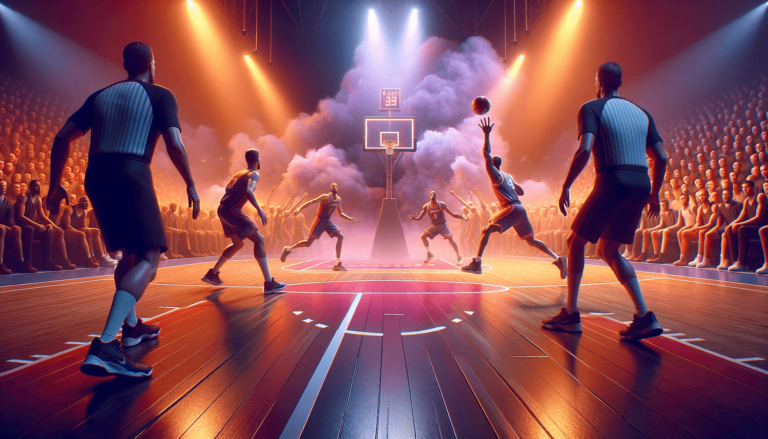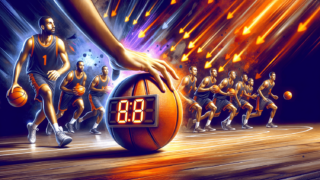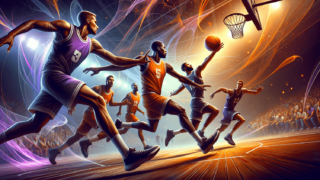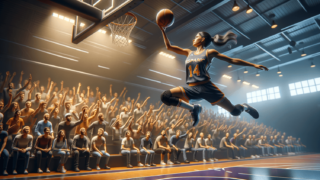
Basketball Lane Violation Rule: How It’s Called
Written by: Basketball Universe
Last updated:

Welcome to the exhilarating world of basketball rules, where even the slightest misstep in understanding a game’s regulations can create significant confusion! In this blog post, we’ll dive into the captivating topic of the basketball lane violation rule and explain in detail how it’s called by referees. Strap in and prepare for an intriguing journey into one of the lesser-known, yet vital, aspects of the game that can impact the outcome of any competitive match. Let our fun and professional tutelage unravel the mysteries behind this seemingly simple rule!
Basketball Lane Violation Rule: How It’s Called
A basketball lane violation occurs when a player enters or occupies the restricted area, known as the key or the paint, for more than three seconds while their team is in possession of the ball. Referees identify this infraction by closely observing players’ positioning and the 3-second timer. If a violation is detected, the referee will blow their whistle, signaling the offense. As a result, the offending team loses possession, and the opposing team is awarded the ball.
Understanding the Basketball Court
Before diving into the details of the basketball lane violation rule, it’s essential to first understand the layout of a basketball court. A standard court is rectangular, with a painted area referred to as “the key” or “the paint.” This area encompasses the free-throw lane, which is typically 12 feet wide and 15 feet long, extending from the baseline to the free-throw line. A semicircular arc, called the three-point line or three-point arc, surrounds the key. Players’ positioning relative to these markings plays a crucial role in determining most basketball rules, such as the basketball lane violation rule.
Decoding the Basketball Lane Violation Rule
The basketball lane violation rule, also known as the three-second rule, exists to prevent players from gaining an unfair advantage by standing too long in the key. The rule mandates that an offensive player cannot remain within the key for more than three consecutive seconds while their team possesses the ball. This restriction applies regardless of whether the player is stationary or moving within the painted area. The rule’s primary objective is to keep the game flowing and require both offensive and defensive players to engage in active gameplay, rather than simply camping out under the basket.
When does the clock start?
The three-second count begins as soon as an offensive player establishes position within the key while their team is in possession of the ball. It’s worth noting that the count is not continuous and resets when the player leaves the key. Furthermore, the count may be temporarily suspended under specific circumstances, such as when a player is in the act of driving towards the basket or making an attempt to secure a rebound.
Referee’s role in the lane violation call
Referees shoulder the responsibility of monitoring player positioning and the three-second timer for identifying lane violations. Positioning themselves strategically, referees stay vigilant for potential violations and deliver a swift call when necessary. Their keen observation and understanding of the game dynamics ensure that players adhere to the rules and maintain a fair and engaging contest.
Knowing the Exceptions to the Basketball Lane Violation Rule
Though seemingly straightforward, the basketball lane violation rule has some nuances that allow exceptions under certain circumstances. These exemptions help accommodate various game scenarios and maintain fluidity while upholding the principles of fair play.
Shots and free-throws
The three-second count is suspended when a player from the offensive team shoots the ball, anticipating that it will hit the rim. This allowance enables players to fight for the rebound without violating the rule. Additionally, the count is reset during free-throws, preventing an incidental violation during a free-throw attempt.
Defensive three-second violation
Interestingly, there’s a counterpart to the lane violation rule that applies to defensive players, called the defensive three-second violation. This rule prohibits defenders from spending more than three consecutive seconds in the key if they’re not closely guarding an offensive player. This stipulation balances the restrictions placed on both offensive and defensive players while preventing a logjam under the basket.
Consequences of Basketball Lane Violations
Comprehending the implications of basketball lane violations is crucial for players and coaches alike. The consequences vary based on the type of infraction – offensive or defensive – and help keep the gameplay fair and competitive.
Offensive lane violation
Upon committing an offensive lane violation, the player’s team loses possession of the ball. The opposing team takes control of the ball and is awarded a throw-in, providing them an opportunity to launch a counterattack. Coaches and players should ensure that they maintain positional awareness to avoid such turnovers, as they can influence the game’s outcome, especially during tight contests.
Defensive lane violation
When a defensive player commits a lane violation, their team receives a penalty, akin to the offensive violation. In this case, the opposing team is granted a technical free-throw attempt and retains possession of the ball after the shot. As a result, the offensive team stands to potentially benefit from the violation, making it important for defenders to respect the three-second rule.
Strategies for Avoiding Lane Violations
Incorporating tactics and coaching strategies to steer clear of lane violations can prove instrumental in minimizing unnecessary turnovers and penalties. Here are a few tips to help players avoid committing these infractions.
Staying mindful of positioning
Players should continuously assess their positioning on the court and ensure they don’t inadvertently wander into the key for extended durations. Regularly monitoring one’s position allows for quicker adjustments, reducing the likelihood of violating the three-second rule.
Leveraging effective communication
Effective communication between teammates can help players remain aware of potential lane violations. Alert teammates can remind a player to exit the key if they’re approaching the three-second limit, preventing the violation from occurring.
Developing basketball IQ
A well-rounded basketball IQ encompasses an in-depth understanding of various basketball rules, game situations, and the ability to make smart decisions in real-time. Developing a strong basketball IQ enables players to maintain positional awareness and respond to various game scenarios promptly and accurately. This level of aptitude minimizes the chances of committing lane violations and contributes to overall success on the court.
Mastering Other Aspects of Basketball Rules
Though understanding the basketball lane violation rule is a critical part of mastering the game, there are numerous other rules and regulations that demand attention. Becoming proficient in these basketball rules not only improves decision-making during competitions but also fosters a more enjoyable and knowledgeable experience for players and fans alike. As the saying goes, “knowledge is power” – and a deeper understanding of the game’s intricacies can propel one’s basketball journey to new heights.
Personal and technical fouls
Recognizing the different types of fouls and their consequences allows players to minimize unnecessary penalties and gain a competitive edge. Comprehending the nuances of personal fouls, technical fouls, and flagrant fouls can enable players to play smarter and more effectively.
Understanding out-of-bounds and possession rules
A comprehensive knowledge of out-of-bounds and possession rules is vital for players to make quick, strategic decisions on the court. Players can maximize their team’s possession time and improve their overall performance by capitalizing on these rules.
Mastering basketball-specific strategies
Beyond the realm of basketball rules, a variety of offensive and defensive strategies can help elevate a team’s performance. By mastering tactics such as pick-and-rolls, zone defenses, and fast breaks, players can leverage their understanding of the game to overpower their opponents.
Transforming Basketball Knowledge into On-Court Success
Demystifying the basketball lane violation rule is a crucial step towards mastering the game’s many facets. By honing their basketball IQ, understanding the consequences of various rules, and applying effective strategies, players can significantly enhance their performance on the court. As with all endeavors, constant practice, diligence, and a keen passion for the game remain the keys to unlocking one’s full potential and achieving on-court success.
A Closer Look at the Evolution of the Lane Violation Rule
The lane violation rule has undergone several changes since its inception, reflecting the evolving nature of basketball and the desire to maintain a balanced and competitive playing environment. A trip down the memory lane of basketball history offers valuable insight into the rule’s development and its impact on the sport as a whole.
The Birth of the Lane Violation Rule
The original basketball court design, developed in 1891 by Dr. James Naismith, did not feature the distinctive key we see today. However, by the early 20th century, the court had already been updated to include a more confined area similar to the modern-day key. The introduction of the lane violation rule in the 1930s aimed to prevent taller players from gaining an unfair advantage by loitering in the key and making it virtually impossible for shorter players to score.
Widening the Key
The width of the key has expanded over the years, partly to account for the increased size and athleticism of players, and partly to reduce congestion around the basket. These changes have influenced the dynamic of the game by providing offensive players with more space to maneuver and, in turn, enhanced the role of the defensive three-second rule to maintain competitive balance.
Introducing the Defensive Three-Second Rule
The adoption of the defensive three-second rule in the early 2000s was a significant development in the context of basketbalI lane violation regulation. This rule mandated that defenders could no longer linger in the key without actively guarding a player, creating a more balanced playing field for both offensive and defensive players.
Applying Knowledge to Different Levels of Basketball
Understanding the basketball lane violation rule and its implications is equally important for players and coaches across all levels of the sport, from grassroots to professional leagues. Each level has its nuances, though many aspects of the rule remain consistent across the board.
High School and College Basketball
While high school and college basketball regulations generally adhere to the fundamental principles of the lane violation rule, it’s crucial for players and coaches to familiarize themselves with any variations specific to their league or governing body. For example, the dimensions of the key and three-point line might differ slightly between high school, NCAA, and international courts, impacting the application of the rule.
Professional Basketball Leagues
In professional leagues such as the NBA or FIBA, the lane violation rule is stringently enforced by seasoned referees. High-level players must possess a thorough understanding of the rule and its nuances, as the fast-paced nature of professional games demands rapid decision-making and flawless execution. Maintaining positional awareness under pressure is key to avoiding costly penalties in these high-stakes competitions.
Referee’s Positioning and Mechanics in Enforcing Lane Violations
Referees play an essential role in enforcing the lane violation rule and ensuring fair play throughout the game. The mechanics of their positioning, signals, and communication are paramount in accurately identifying and calling violations.
Referee’s Positioning
Referees need to have an unobstructed view of the key to effectively monitor player movement and the three-second count. Typically, they’ll adopt a position either on the baseline or along the sideline, affording them ample visibility to spot violations and make accurate calls.
Hand Signals and Whistle Calls
Upon identifying a lane violation, the referee uses specific hand signals to indicate the type of infraction – offensive or defensive – and blows their whistle to halt play. They’ll then communicate the violation details and award the appropriate penalty, ensuring a smooth and fair continuation of the game.
Collaboration with Fellow Referees
Enforcing the lane violation rule, among other regulations, demands seamless coordination and communication between referees. Working as a cohesive unit, they share responsibility for observing the action, crosschecking with each other, and relaying relevant information to provide objective and consistent rule enforcement throughout the game.
Frequently Asked Questions
To help solidify your understanding of the basketball lane violation rule and address any lingering questions, we’ve compiled a list of frequently asked questions covering various facets of the topic. Here, we provide concise answers to enhance your knowledge and clarify common areas of confusion.
What is the purpose of the basketball lane violation rule?
The primary purpose of the basketball lane violation rule is to prevent players from gaining an unfair advantage by spending too much time in the key. The rule encourages more dynamic and active gameplay, ensuring fluidity and engagement for both offensive and defensive players.
What is the difference between an offensive and defensive lane violation?
An offensive lane violation happens when an offensive player stays within the key for more than three seconds while their team has possession of the ball. In contrast, a defensive lane violation occurs when a defender remains in the key for three seconds or more without closely guarding an offensive player. Both violations are subject to different penalties in the game.
Is a player allowed to leave and quickly re-enter the key to avoid a lane violation?
While a player can leave the key to reset the three-second count, they must fully establish their position outside the key for the count to reset. Repeatedly stepping in and out of the key without properly resetting the count may still result in a lane violation being called.
How does a referee determine whether an offensive player is inside the key?
A referee meticulously observes the game and players’ positions, monitoring when an offensive player enters the key. They’ll also consider whether any part of the player’s foot is touching or hanging over the boundary lines. If even a toe is touching the line, the player is considered to be inside the key.
What happens when a basketball lane violation is called on an offensive player?
Upon an offensive lane violation being called, the offending team loses possession of the ball. The opposing team is awarded a throw-in, giving them an opportunity to launch an offensive play and potentially score points.
What are the consequences of a defensive lane violation?
When a defensive lane violation is called, the violating team is penalized with a technical free-throw attempt awarded to the offensive team. The offensive team retains possession of the ball following the free-throw attempt, giving them an opportunity to capitalize on their opponent’s infraction.
Are there any exceptions to the basketball lane violation rule?
Yes, there are a few exceptions to the rule. The three-second count can be suspended during shots, as long as the ball is anticipated to hit the rim, and during free-throws. The count may also be temporarily stopped when the player is in the act of driving towards the basket or attempting to secure a rebound.
Do the dimensions of the key change across different basketball levels?
Yes, the dimensions of the key and three-point line may vary slightly between different levels of basketball, such as high school, NCAA, and international competitions. Familiarizing oneself with the specific court dimensions and markings for the relevant level is essential for understanding the application of the lane violation rule.
How can I prevent committing a lane violation during a game?
To avoid committing a lane violation during a game, maintain good positional awareness, communicate effectively with your teammates, and actively work on developing your basketball IQ. Strong decision-making skills and a thorough understanding of the game’s rules will significantly reduce the likelihood of incurring violations.
Is the lane violation rule enforced during informal games and pick-up basketball?
While the enforcement of the lane violation rule during informal games and pick-up basketball largely depends on the participants, it’s generally advised to follow the rule to maintain fair play and foster a competitive atmosphere. Familiarity with and adherence to basic basketball rules, even during casual games, helps to cultivate good habits on the court.
Featured Posts
- No pillar pages found.





